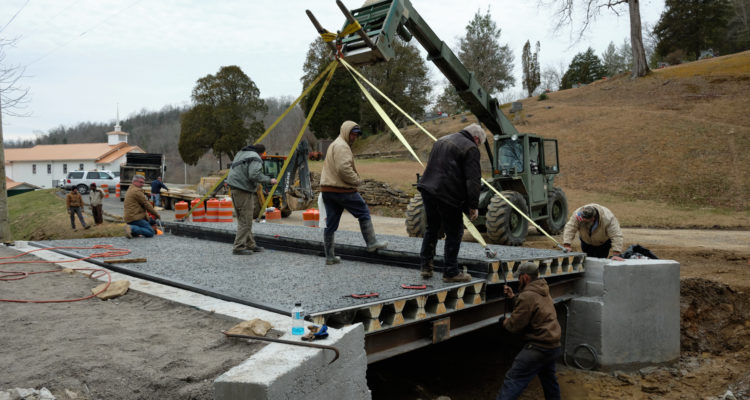McKinney Excavating demolished the existing bridge and built the concrete foundation for the FRP composite decking. Other companies that contributed to the project included Compsys Inc. (PRISMA® composite preforms), Interplastic Corporation (resins), West System (epoxy resin), Superior Fiberglass and METYZ (fiber reinforcements) and AcraLock (adhesives).
All of the partners agreed to contribute their labor and materials. This was welcome news for Morgan County, which, like many rural communities, has a very limited budget for infrastructure repairs. Since the bridge has a 100-year life span, the county will also save money long term.
There was a benefit for Morgan County motorists as well. Since the bridge decking was manufactured in the factory rather than in the field, they didn’t have to deal with long, inconvenient road closures.
Structural Composites designed the bridge and built the decking in two modules, both measuring 8 x 25 feet. Each module consisted of two single-skin PRISMA preform sections, which were joined together in the factory at the raised frame caps.
“The two sections can be produced with a range of production methods, from low-volume open molding to closed molding to continuous molding,” says Scott Lewit, president and co-founder of Structural Composites. “They can be made to work with open molding/wet lay-up or adapted to infusion or to vacuum assisted resin transfer molding. This allows the technology to scale based on the manufacturing base and market demand.”
One technological breakthrough on the Morgan County bridge was the method of applying the asphalt wearing surface to the composite decking. This typically happens on-site after the bridge is installed. “We felt it was very important to get that out of the field and into an environment where everything was controlled,” says Lewit. “Our system comes with a technology – CoCure® combined with aggregate – that makes a super tough wear surface. The urethane component gives us a really strong adhesion to the deck.”
The completed bridge sections were placed on a flat-bed semi-trailer and transported to Morgan County. Because the sections were so lightweight, crews were able to install them in one day using a forklift. There was no need to rent a crane, which further reduced installation time and costs.
The bridge opened to traffic in the spring of 2021. McCay says that Miller is sold on the benefits of composite decking and hopes to use it again on other bridges that need repair. The Tennessee Department of Transportation (TDOT) has also expressed interest in the technology. “The use of fiber-reinforced polymer bridge deck units … has the potential to greatly enhance the performance, durability and service life of our low-volume rural bridge network across the state,” said Ted Kniazewycz, TDOT structures division director, in a statement.
The project partners are confident that the Morgan County bridge will serve as a model for other jurisdictions looking for cost-effective, long-term solutions for fixing their bridge infrastructure. While they hope the performance data they collect will convince state DOTs to try out the composite decking on larger bridges, they realize they have uncovered an urgent need in rural communities and found a solution that will work well for them. Lewit says he would like to see democratized or distributed manufacturing of the technology. That approach would allow local composite fabricators to build the decking components for bridges in their areas, bringing more jobs into those communities.
In the meantime, the bridge in Morgan County has already yielded many benefits. “It was a win/win/win project,” says McCay. “It was an opportunity to get a technology that could be a game-changer out in the marketplace, to do it in a community that has a need that gets fulfilled and to collaborate with other companies in the industry.”



